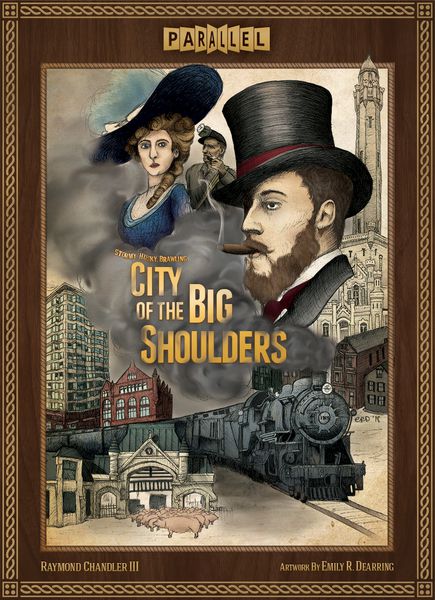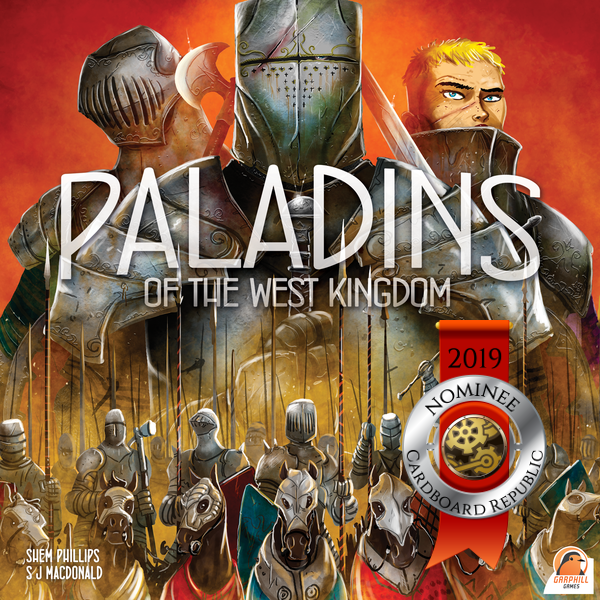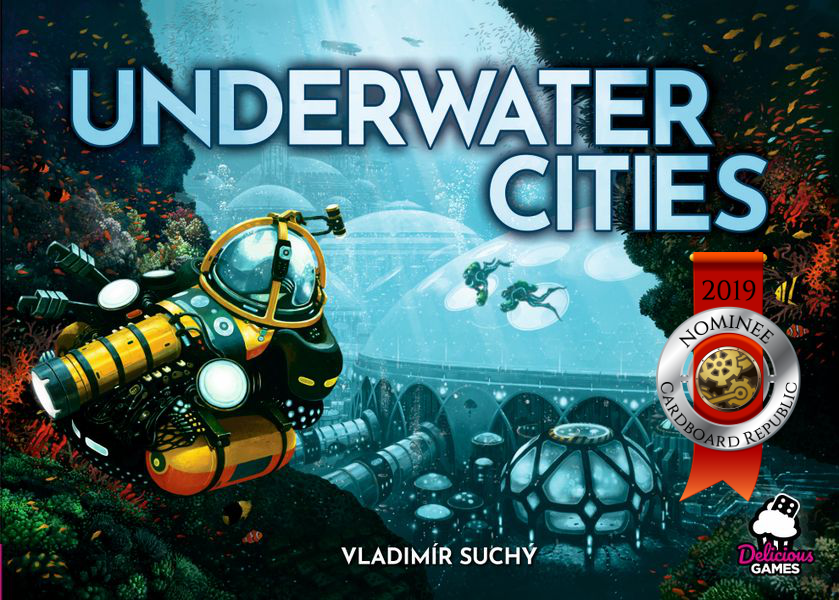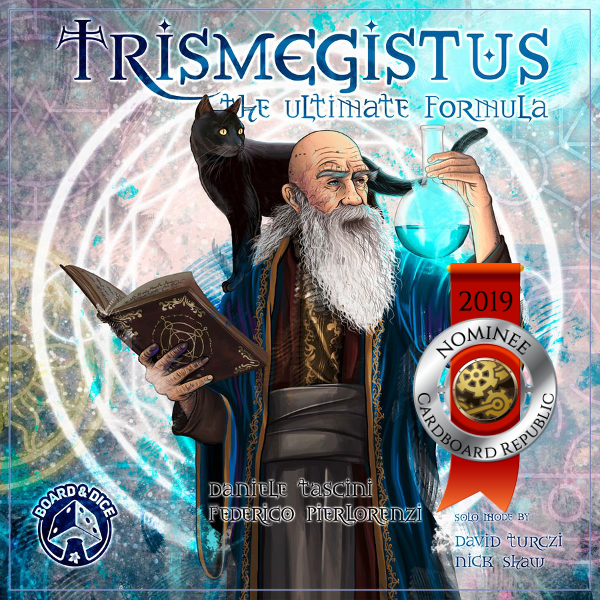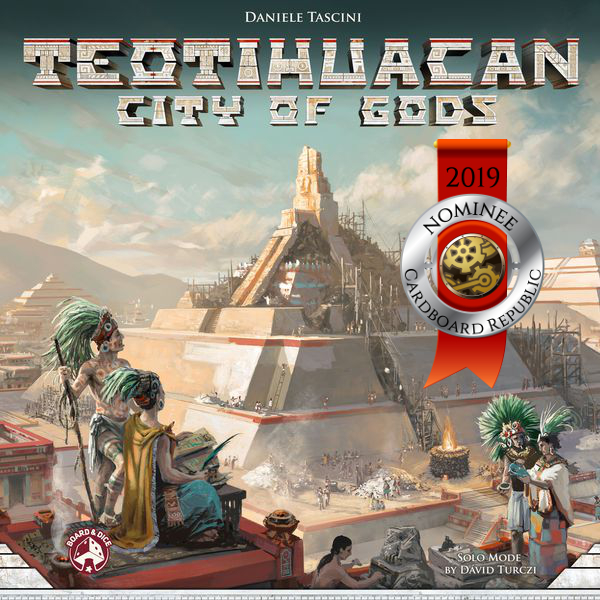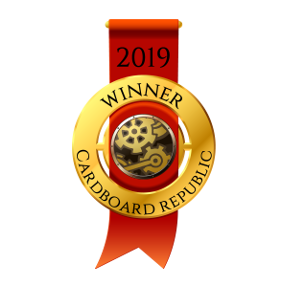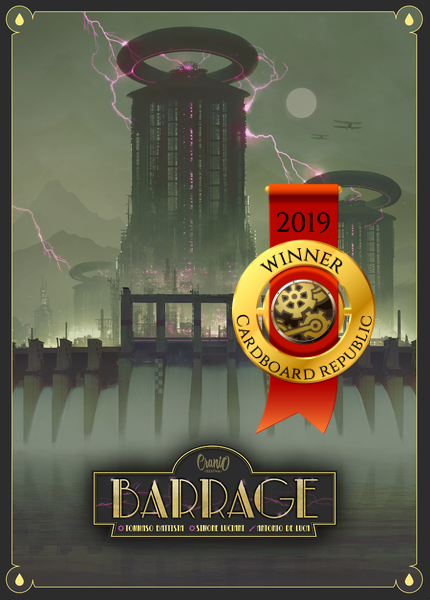The Cardboard Republic has rolled out the annual Laurels of the Republic awards, celebrating the best new games released in 2019 for each of the gamer archetypes. What follows are the finalists for one of those groups.
 The greatest moment for a Tactician isn’t when they cross the finish line or they best another player. Rather, it’s when all of their moving pieces and disparate strategic decisions coalesce as their carefully laid plan comes to fruition. Always the consummate schemers, Tacticians adore games that not only let them look at things in the long term but are flexible enough that it can be accomplished in different ways. Most Tacticians use layers to their plotting, adjusting if things don’t go exactly as they’d hope – which is almost guaranteed – and they’re adept at leveraging turn-based options to the fullest even if the game doesn’t permit focusing on a grand vision.
The greatest moment for a Tactician isn’t when they cross the finish line or they best another player. Rather, it’s when all of their moving pieces and disparate strategic decisions coalesce as their carefully laid plan comes to fruition. Always the consummate schemers, Tacticians adore games that not only let them look at things in the long term but are flexible enough that it can be accomplished in different ways. Most Tacticians use layers to their plotting, adjusting if things don’t go exactly as they’d hope – which is almost guaranteed – and they’re adept at leveraging turn-based options to the fullest even if the game doesn’t permit focusing on a grand vision.
And with that, here are The 2019 Laurel Finalists for Tacticians:
Honorable Mention: City of the Big Shoulders
Publisher: Parallel Games | Players: 2-4 | Play Time: 120-180 Minutes
When it comes to lengthy and complex games that require extensive investment of time and energy, few fit the bill more than the 18XX genre. 18XX train games have held a long and beloved history in board gaming, combining a love of route building, economic manipulation, and cutthroat business management. These games are math heavy, have an enthusiastic fanbase, and the majority have a starting play time of 2-3 hours – all of which makes it rather intimidating for the uninitiated.
Thing is, they can also be quite a lot of fun.
In recent years there has been some experimentation to create games to bridge that divide. And arguably the most successful thus far has been the amusingly train-free City of the Big Shoulders.
CoBS’ initial coverage created some confusion touting it as a true Euro-game / 18XX hybrid with the potential to appease both groups. But despite being a rather meaty Euro game, it is largely treated as too light for the rail gangs. Rather, this game’s merit is as a stepping stone from standard Euro gaming fare into something larger. And it does so with aplomb.
City of the Big Shoulders is a worker placement game mixed with an 18XX style stock system set in Chicago around the turn of the 20th century. Each player begins with control of a Chicago-based company. Over the span of several rounds, players use a slowly-evolving slate of action spaces to hire workers and automation to run the factories, salespeople to increase the product’s value, and raw materials in order to make it, all with the intent of trying to sell the goods for the most profit. The more profitable your company’s production runs, the higher its stock price climbs.
Paired with this process is the game’s simplified-yet-familiar 18XX style stock system that encourages buying up shares of the various companies, decreasing the amount of money the company retains each round but providing sweet, sweet liquid capital to its shareholder’s coffers.
Which is good, because at the end of the game, only your personal wealth matters. You tycoon, you.
City of the Big Shoulders both requires and rewards a deft hand at project management and the perspicacity to adjust your plans when more valuable opportunities arise. Though Tacticians are the one group most likely to enjoy both genres, City of the Big Shoulders deserves recognition for creating a game that caters to their love of ramping up a well-run engine alongside their adoration for long-term payoffs.
So that’s exactly what we’re doing.
The Nominees

Number Five: Paladins of the West Kingdom
Publisher: Renegade Game Studios / Garphill Games | Players: 1-4 | Play Time: 90-120 Minutes
We’re not quite sure how designer Shem Phillips does it, but he has pulled off yet another hit. Building on his experiences creating the North Sea trilogy and following on the heels of one of the highly lauded games of last year with Architects of the West Kingdom (a Laurel nominee in its own right), comes its heftier, more demanding sibling with the sequel, Paladins of the West Kingdom.
Continuing the story established in the first game, although your efforts at re-establishing an estimable frontier city proved successful, that hasn’t stopped the encroachment of outside invaders. In an effort to stave off barbarians, Vikings, and other ne’er-do-wells, the king has dispatched his trusty paladins to the region to help shore up the defenses.
After all, towns are much prettier when they aren’t razed to the ground.
Paladins of the West Kingdom is easily the heaviest and longest title from either of the Garphill series to date, which is borne out with painstaking clarity. Your goal over seven rounds is to muster the collective efforts of the town’s noblemen, artisans, monks, and the visiting paladins to protect your township, with the best one to do so emerging as the victor. The challenge lay in the execution of those efforts. Although the core of the gameplay is mere worker placement, achieving your objectives requires the careful cultivation and management of an ever-changing fleet of workers from six different types.
In this game, workers are destiny, as accomplishing the game’s primary goals of constructing outposts and fortifications, deploying monks, and either fighting or converting the enemies at the gates all require some specific combination of workers. Which workers are available to you each round is determined partially by choosing a paladin card and partially by draft, forcing you to make calculated choices over not only what you want to accomplish but also the best means to optimize the order and timing of your efforts.
Though Paladins of the West Kingdom offers visual similarities to its sister games and general familiarities to its core functions, the underlying framework is anything but a generic facade. Paladins requires ample forethought and proper execution to achieve both short term and long term ambitions, all while knowing full well that both time and workers are limited. As a result, Tacticians will gladly march to the front lines to demonstrate their logistical acumen against heathen and brethren alike.
Number Four: Underwater Cities
Publisher: Rio Grande Games / Delicious Games | Players: 1-4 | Play Time: 90-150 Minutes
Despite it technically being the first title of the Delicious Games brand, it only took those who followed the releases at Essen 2018 a few seconds to realize what they actually were seeing was the personal brand of vaunted designer Vladimir Suchy, noted for titles such as Shipyard, Last Will, and (prior Laurel nominee) Pulsar 2849. Underwater Cities just happened to be his first solo release outside of CGE, and its interest only accelerated from there. It was further boosted when Rio Grande brought the game to the US in mid 2019, opening up a whole new market for enthusiastic Cousteaus in the making.
As the name so aptly describes, Underwater Cities is about trying to build, manage, and profit from the construction of numerous cities beneath the waves. Earth has become overpopulated, and with ample room on the seabed to escape to, it’s up to each player to demonstrate they have the architectural knowhow to run an efficient aquatic metropolis.
Or at the very least prove you have more wherewithal than your neighbors over in Sealab 2021…
In this largely card-driven game, players compete over several rounds playing various colored ability cards to various colored ability slots on the board. Actions in the game are extensive and diverse but usually involve some manner of gathering raw materials, constructing tunnels and biomes, and upgrading facilities such as farms and laboratories to make cities more prosperous. The more productive and efficient your cities become, the more points they’re worth.
Yet while any card can be played to any open slot, only by pairing up color-wise do you benefit from both actions. Moreover, because each space is limited, you’re forced to prioritize your order of card usage each round; routinely finding yourself plotting out multiple contingency plans is both expected and essential.
Indeed, success in Underwater Cities isn’t solely a manner of grand vision. Instead, the game superbly blends the importance of long term goals with the need to tactically determine the best benefits based on where the cards and currents carry you. The resulting combination of these efforts, alongside an intriguing theme and extensive card variability, plunges you into a deeply gratifying experience that Tacticians will be more than eager to dive into.
Number Three: Trismegistus: The Ultimate Formula
Publisher: Board & Dice | Players: 1-4 | Play Time: 90-120 Minutes
What if we said that in Trismegistus, your primary action throughout the entire game is to draft just nine dice? Then what if we said that fully unwinding this process can take the better part of two hours? Because that’s exactly what you get in this puzzle-laden game of triumph and transmutation.
Two things have become increasingly evident regarding the Board & Dice team. The first is that they have developed a knack for clever, intriguing, and highly compelling middle-to-heavyweight Euro games that utilize a host of different effects and mechanics. The second is that they then deftly overlay these foundations with distinctive premises, creating games that are as notable for their concepts as much as their gameplay.
In the case of their latter 2019 release, that means Trismegistus, a game about alchemy with a one heck of a thematic deep cut regarding its namesake.
Really. We don’t have time to go into details about purported existence of Hermes Trismegistus – the first True Metal Alchemist – or his lasting effect on Western civilization, but designing a game around being his fabled successor is an interesting concept – even if it doesn’t directly tie into your decisions.
Over three rounds, each player will draft exactly three dice from a central pool and spend several subsequent turns extracting all of its arcane potential. Those efforts include gathering resources, performing transmutations, acquiring and activating artifacts, and / or fueling experiments. However, this seemingly simple approach belies much of the game’s extensive complexity, for the potency of each die depends on the order it was drafted, while many of the desired actions care solely about either that die’s color or symbol.
In Trismegistus, everything revolves around determining which dice to take, when to take it, and how its particular combination of features will net you the most worthwhile series of actions. Chaining process-driven action sequences together is the heart of the game, and although efficiently doing so is the recipe to success, the byproduct is immense satisfaction when you’re able to pull them off. Encouraging both long-term ambitions and turn-based optimization, has whipped up precisely the right ingredients to keep Tacticians spellbound.
Which is downright impressive with just nine dice.
Number Two: Teotihuacan: City of Gods
Publisher: Board & Dice | Players: 1-4 | Play Time: 90-120 Minutes
While there are a lot of excellent games released annually befitting the entire gamer spectrum, narrowing it down to the 30 most emblematic titles across each of their respective archetypes amounts to a very small portion of potential candidates. Even rarer still is the prospect of a publisher winding up with multiple titles in the same category.
But it has happened before, and it’s happened again. Because that’s precisely what Board & Dice has managed here.
Teotihuacan burst onto the scene in Essen 2018, quickly becoming one of its most talked about titles due to its engaging gameplay, deceptively deep strategic potential, and stunning table presence thanks to the board’s centralized pyramid. It rapidly earned extensive praise and made itself a fixture on many outlet’s annual Best Of lists. However, Teo didn’t officially become available in the US until early 2019, which is why we’re celebrating it here today.
Beneath its colorful motifs and icon-strewed visage, Teotihuacan is a dice worker placement meets rondel game in which the actions available to you and the strength of their effects reside as much with the value of your dice at a location as the number of your dice present.
When we said Board & Dice were on a roll, we meant it both literally and figuratively.
Over the span of three eras, players in Teo move around the board to different locations. These locations are used to gather resources, gain status in the temples, develop new technologies, and of course, help assemble the central pyramid. Workers who…work…increase in value, raising their efficacy at taking at later actions. Having additional workers at the same location boosts the location’s effect even further. Workers who reach level 6 “ascend”, and a new worker takes their place, creating a continually changing cycle of values to juggle.
What makes Teotihuacan so appealing is the means by which you can execute your actions. By carefully chaining your worker activations in specific orders, turns can be as lucrative as they are personally fulfilling. Teo is deep enough to allow you plot multiple moves ahead for valuable payoffs while still possessing extensive levity to adjust tactics on the fly based on the actions of other players. These factors, when combined with its production quality and extensive modularity, make for a captivating yet approachable worker placement worthy of the gods themselves. More importantly though, it’s just the kind of game that the ever-calculating Tacticians can’t say no to – making it quite worthy of its runner-up status.
In fact, for quite some time it was prophesied it may have even taken the top spot itself, save for another title that came sailing downriver a short while later…
The Winner
2019 Tactician Laurel – Barrage
Publisher: Cranio Creations / Asmodee North America | Players: 1-4 | Play Time: 90 Minutes
Of all the finalists in this year’s Laurels, the margins on this one proved to be the closest. Not because they offer the same experience but because the tradeoffs between the two proved to be hard to easily contrast. For what Teo takes away from Barrage in terms of being a slightly more accessible game with wider audiences, Barrage more than makes up for by putting forth an experience that not only invites players to consider their actions several moves ahead – it demands it.
And from that lens, everything fell into place like rain in a mountain lake.
Set in an alternate-reality postwar 1920s Europe, fossil fuels have largely been depleted and hydroelectric power has become the new energy arena to compete over. The goal, simple though it sounds, is to be the most prosperous hydro energy magnate in the region. In this weighty worker placement game, your task is to build dams to store up water reservoirs, erect power stations to generate electricity, and connect supply lines between them to ensure unfettered access between the two.
The catch is that building all of this equipment is costly in terms of the needed resources, as well as the fact that the process is not automatic. Using an innovative rondel-like wheel, building structures requires locking in your resources for several turns, forcing you to be judicious in the timing of your construction while using your other workers to organize for its eventual completion.
To make matters worse, along these mountainous slopes everyone else is trying to do the same thing. And in Barrage, trouble rolls uphill.
In this game, controlling access to water is paramount; nearly every one of your actions in some way is shaped around that effort. Well-honed timing, calculated moves, and forward-thinking are essential to that end. Everything is tightly contested, from available finances, to the amount of time you have to accomplish your tasks, to the very water supplies themselves. Having an underutilized power station can be just as detrimental to your bottom line as someone building a dam further upriver and cutting off access. It’s your job to minimize both.
Barrage made a splash early in 2019 but was beset early on due to some production missteps during its Kickstarter, leading to some initial brushoffs regarding its inherent worth. Yet those who did will miss out on an exemplary logic puzzle that champions the very elements that Tacticians crave, with an emphasis on strategic planning and the thrill of leveraging disparate actions into sizable payoffs. All of which Barrage provides in copious quantity.
And with all that in mind, there’s little doubt that Barrage is deserving of the Tactician Laurel of 2019.
![]()
Barrage Contest!
When we were finalizing this list a while back, we wanted to come up with some way of drawing attention to how impressive the winner of the Tactician Laurel is. We brainstormed numerous ways that we could celebrate the detailed and intricate construction management nature of Barrage without having to spend ourselves into poverty in doing so. Because trying to have everyone help construct a new dam project would be prohibitively expensive and we’re pretty sure we’d getting trouble with the Environmental Protection Agency, US Fish & Wildlife, the Park Rangers, the Bureau of Land Management, and Union Local 319…again. It’s bad enough when just one of those groups is unhappy with your ‘flagrant disregard of rules and regs’, but the whole lot of them at once? Whoo boy, not again, no.
But that’s another story…
So we played around with different ways to champion the game instead, such as having each person host a 6th grade science fair project presentation on the wonders of electricity, or seeing how close one can get to a beaver dam before being swatted away by some angry aquatic mammals. We briefly even considered hosting a contest to see who could come up with the best cement sculpting over a two-hour period, but then words like ‘lawsuit’ and ‘waste of resources’ kept getting tossed around, forcing us to abandon that one altogether. But it would have been glorious.
At any rate, in the end we realized that the easiest option was to simply go with the flow by providing one lucky winner with the opportunity to enjoy this award-winning game first hand in exchange for a simple contest entry.
That’s right! Enter below for your chance at your very own copy of Barrage!
One Copy of Barrage
Note: Due to the current circumstances around the coronavirus pandemic and supply chain disruptions, delivery of this title to the winner likely may be delayed by upwards of several weeks.
![]()
Be sure to check out the 2019 Laurel Award pages for the other archetypes once they go live!

